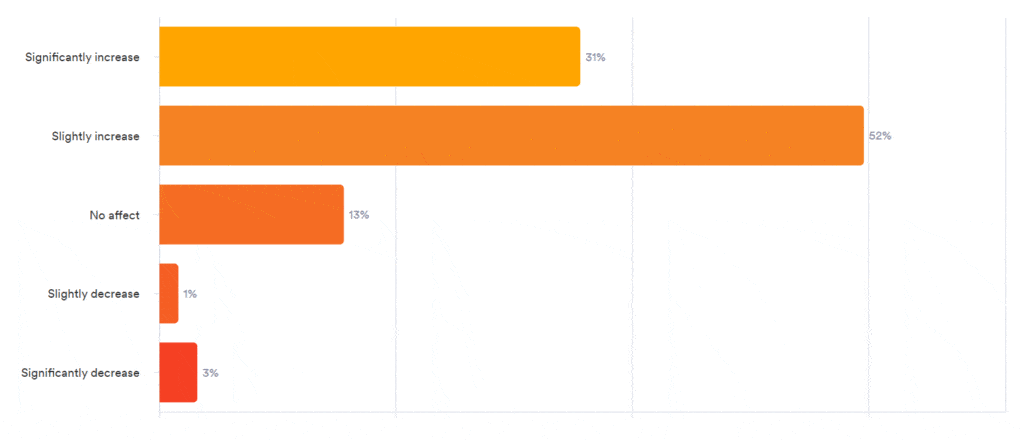Last month, the LANDTHINK Pulse posed the following question to our audience: How will lower interest rates in 2024 affect the demand for land sales?
Our informal online survey revealed that 52% of respondents believe that lower interest rates will SLIGHTLY INCREASE the sale of rural land. This was followed closely by 31%, who said that the pace of the market would SIGNIFICANTLY INCREASE if interest rates continue going down.

Between low inventory and high interest rates, 2023 was a tough year to buy land, but things could change in 2024. With mortgage rates hovering around 7% and the Federal Reserve putting interest rate cuts in its forecast, experts and economists are optimistic about the 2024 real estate market.
Understanding the Basics
The connection between interest rates and mortgage rates is foundational to comprehending the real estate landscape. The Fed funds rate sets the tone for the country’s economic outlook and is the basis for many other interest rates. As the Fed funds rate rises, interest rates, including mortgage rates, tend to follow. As interest rates fluctuate, so do the costs associated with obtaining a mortgage, forming the cornerstone of the interest rate-real estate price relationship.
Price Sensitivity
High interest rates and reduced affordability: When interest rates are going up, the cost of owning property becomes more expensive due to the higher interest rate. Rising interest rates can dampen buyer enthusiasm or affordability, slow down land sales or lead to a drop in prices.
Low interest rates and increased demand: Conversely, when interest rates are low, mortgage rates follow suit. This affordability boost often triggers heightened demand as prospective landbuyers find themselves empowered with more purchasing power. Lower interest rates tend to create a more dynamic and competitive market for buyers and frequently translates to an uptick in land prices. The lowered interest rates may invigorate the market, attracting more buyers and potentially driving up land values. While declining interest rates open the door to new opportunities for buyers, it also sets the stage for a competitive and potentially expensive land real estate market.
Bittersweet Times for Potential Land Buyers
Lower interest rates are a mixed bag for buyers as the land market continues to change. Sure, it signals more accessible mortgage options, but it’s also a precursor to a potential increase in prices. Why? Let’s look at the economics of it.
Supply and Demand: One of the biggest challenges in the current land market is lack of inventory. Buyers are actively searching for and purchasing land, but there just isn’t enough land for sale to meet the growing demand.
The Domino Effect: Lower interest rates boost buying power, leading to more people searching for land for sale. But with no matching increase in inventory, this demand pushes land prices up.
Interestingly, the rural land market operates differently from the general housing market, and experiences its own unique trends. In general, land buyers are less concerned with interest rates. Cash purchases have increased and with dramatic swings in both stocks and cryptocurrency values, investors have leaned on land as a stable cornerstone of their portfolio. Higher-net-worth buyers flock to property in tumultuous times. Hard assets like timberland and farmland are a good hedge against both inflation and economic downturns. They can provide a continuous cash flow from leases and timber income, as well as tax benefits.
The Federal Reserve’s potential policy shifts are set to play a pivotal role in shaping the land real estate market. Projections have the Fed cutting rates several times in 2024. If these predictions materialize, we could see an economy grappling with a significant slowdown and rising unemployment rates. During periods of strong economic growth and falling unemployment, the Fed is more likely to raise interest rates to cool wage growth and keep a lid on potential inflation. However, officials are more likely to lower rates during periods of weakening economic activity and rising unemployment to spur economic growth.
But what does this mean for the rural land market? Typically, an economic downturn leads to a dip in prices. However, the current scenario is anything but typical. With persistently low inventory levels, we may see a paradox where rural land values sustain or even rise despite broader economic challenges.
For buyers, the current land market dynamics present unique challenges and opportunities.
Prepare for Competition: When interest rates come down, the velocity of buyers entering the marketplace will immediately accelerate. This means increased competition, particularly due to the existing low land inventory.
Be Ready to Act Quickly: While the market is shifting to favor buyers, thanks to better interest rates, you’re going to have to be decisive. Once you locate property that you like, don’t let your land get away. You may not have time to sleep on the decision.
Key Strategies:
- Stay Informed: Keep abreast of market trends and new land listings.
- Get Pre-Approved: Some buyers cannot afford an all-cash offer and will need to pursue financing. In order to set yourself apart from other buyers, you’ll need to get pre-approved for a land loan.
- Work with a Land Agent: Just like in sports, you want to have the best players on your team when facing tough competition. Buying land is a complex transaction, and it’s not something you’ll want to do on your own. A land agent is committed to protecting the buyers’ interest.
As 2024 hits its stride, it’s important to keep a close watch on the Federal Reserve’s actions and how the land real estate market will subsequently respond. Equally important is to monitor inventory levels in your local area. Land real estate is intricate and constantly evolving. However, one thing remains certain: with declining interest rates and tight inventory, we may be on the brink of a land market boom. Staying informed of industry trends and changes, being adaptable to rapid changes, and poised to capitalize on these market dynamics is more important than ever.
Do you have a suggestion for next month’s Pulse question? Submit your question and we might choose yours!
This content may not be used or reproduced in any manner whatsoever, in part or in whole, without written permission of LANDTHINK. Use of this content without permission is a violation of federal copyright law. The articles, posts, comments, opinions and information provided by LANDTHINK are for informational and research purposes only and DOES NOT substitute or coincide with the advice of an attorney, accountant, real estate broker or any other licensed real estate professional. LANDTHINK strongly advises visitors and readers to seek their own professional guidance and advice related to buying, investing in or selling real estate.










Add Comment